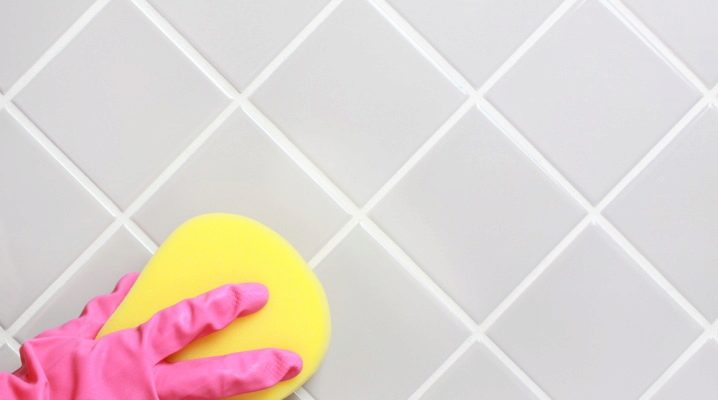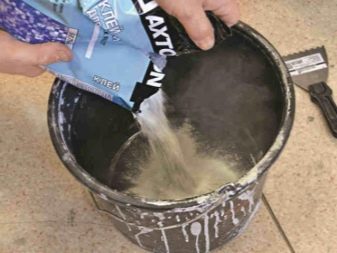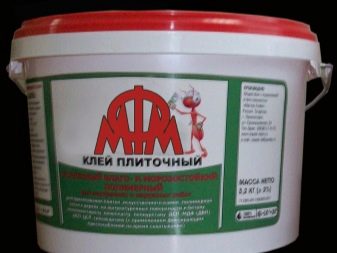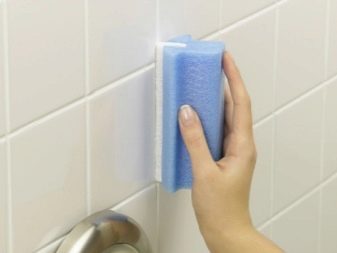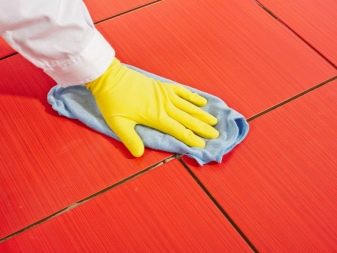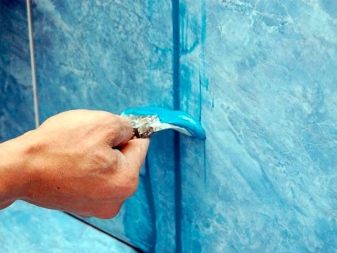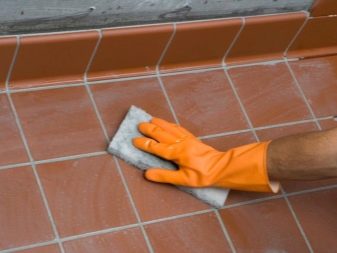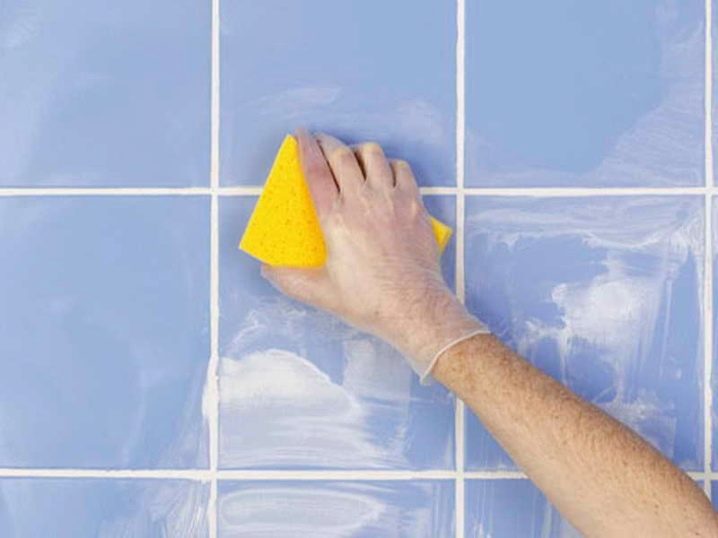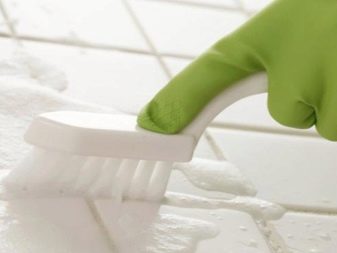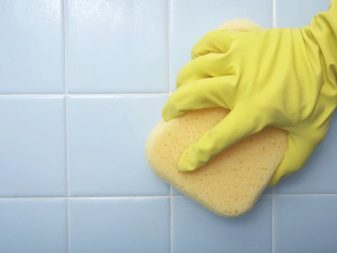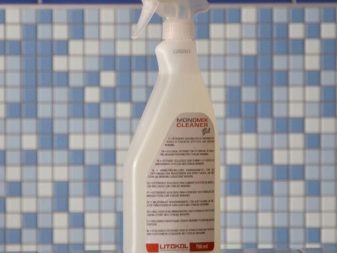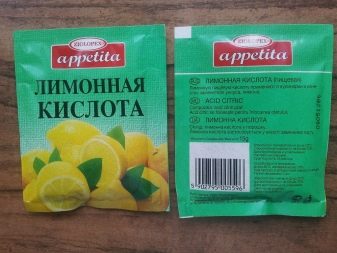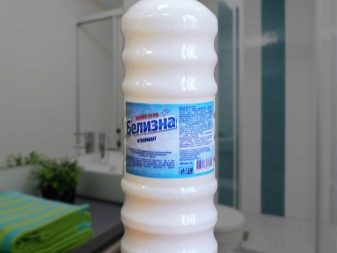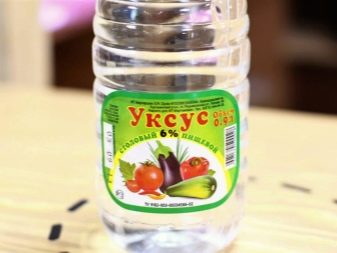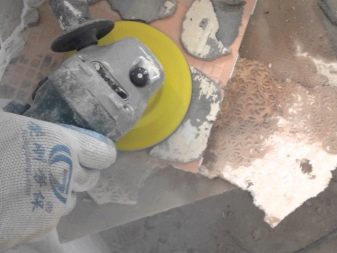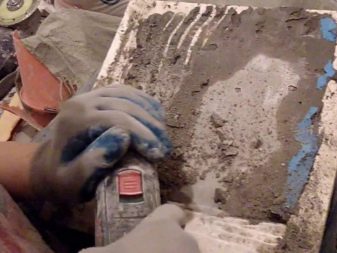How to clean tile tiles from glue?
After the termination of the internal finishing of the tile, the traces of glue must be left on the tile and must be removed. It is impossible to leave the facing in this form, because the appearance of the bathroom or kitchen will be unattractive, and the material will accumulate in itself bacteria that worsen the hygienic conditions.
Depending on what kind of glue was used for work, there are a number of ways to remove dirt using special or available tools.
Types of tile glue
The attachment material may contain various components. The drying rate, the durability of the result and the method of applying glue to the wall depend on the composition. Therefore, the methods of cleaning ceramics from different adhesive materials differ from each other.
Among the glue bases it is customary to single out:
- Cement glue. A plastic material often used by tile masters. Dense density allows the tile to fit well on the wall. The quality of such glue depends directly on the impurities added to the solution during its preparation.
- Epoxy adhesive contains synthetic resins, thanks to which the base hardens slowly. Because of this, it is not popular among builders, and it can be difficult to wash it away even from a glossy surface. Special solvents are usually used for cleaning, which can be purchased at any building materials store.
- Polymer adhesive Popular on a par with cement. It looks like a gel or paste, which quickly hardens. The composition contains acrylic, so you can clean off the pollution only after applying a special acrylic solvent.
- Homemade glue. To save on the purchase of factory material, many builders have their own recipe for making a tile adhesive base. Typically, the composition of such a solution includes cement with sand, which are added in certain proportions. If the proportion of sand will significantly exceed other components, the material will turn out flowing and will not be able to fix the coating elements.Of the advantages is the ability to personally control the composition of the mixture, which will facilitate the choice of means for cleaning the surface of the adhesive.
It should be remembered that if the mixture is quickly solidified, then the stains from it must be removed as soon as possible, otherwise it will be extremely difficult to clean off the dried out traces on the front of the traces.
Methods for cleaning the surface from glue
Before removing adhesive stains, it is advisable to familiarize yourself with the type of mixture applied to the wall during repairs. Each cleaning method will be effective in its own way on different adhesive compositions.
Fresh glue
Finishing works require maximum accuracy when applying the solution. But there are cases when the surface of the tile "suffers" from excess stains. This happens when the glue protrudes at the site of the seams or when it is accidentally touched to the tile that has already been laid.
At such times, it is necessary to immediately wipe the stained surface, preventing solidification.
Each laid rectangle must be cleaned with a rubber trowel, removing excess glue, tread on the joints. Then you need to rinse the spatula in warm water and remove the smudges formed on the surface of ceramics.
For maximum effect, you will need to wet a rag or sponge in warm water and wipe each segment where there was dirt.
Moisture wiped with a dry cloth to prevent water from mixing with glueotherwise, such a raid will be impossible to wash off.
If during work one of the tiles is randomly stuck crookedly or too pressed into the base, it is not a problem. You can knock off the edge of the element with a spatula and separate it from the wall until the glue is dry. The back surface (turned to the wall) must be cleaned of the mortar and re-glued in place, observing great accuracy.
There have been cases when unscrupulous masters did not adhere to this technology due to the fact that it requires a lot of time. After all, in this case it is necessary to gradually gloss over small areas of the wall with glue so that during the wiping of the tile the uncoated base does not harden. In addition, most mixtures have a limited duration of exposure to air in the liquid state, so they need to have time to use for a few hours.
To avoid the loss of expensive material, it is often necessary to prepare a new mixture in small quantities.
Well, if there is an assistant who will instantly wipe the tile after laying, but if it is not there, then you will have to work slowly.
Hardened glue
If the finishing work is finished, and at the same time, the tile still has dried up traces of glue base, you will have to remove them manually. The main thing is to start cleaning as early as possible in order to increase the chance to completely remove stains. Quick-drying mixtures finally harden for two to three days, and normal ones in a week.
Therefore, you should hurry to remove the mixture in a semi-drained condition, otherwise you will have to use aggressive chemicals that can spoil the appearance of the tile itself.
A rag and trowel will not help here, so you need to exert a little more effort, consistently performing the cleaning steps:
- First you need to wet the stain with water. This will allow the mixture to soften and less tightly interlock with ceramics.
- Usually the stain is not completely soaked with moisture. Only peripheral layers become soft, which should be removed with a sponge. It is better to try to clean the rest of it with pumice, hard brush or sandpaper, without touching the lining itself.If we are talking about small drops - they can be cleaned with a nail file, but this option will not work for bulky spots.
- If the mixture is already scraped off with difficulty, then there is no need to hurry and make great efforts, because it is possible to aggravate the situation. It is better to repeat the procedure of wetting with water, wait until the upper layers are softened again, and then clean them again with a sponge. So you need to repeat until the stain is equal to the tile.
- Now you need to put aside all the hard methods and take softer tools. The last layer needs to be wetted and cleaned with a standard hard sponge or an old toothbrush. It is not necessary to use household chemicals.
If everything is done correctly, then in the end you can achieve the desired result. As with the laying of tile when cleaning it is important to avoid haste.
Chemicals used in removing adhesive stains
The use of household chemicals is required in cases where the tile adhesive is completely hardened. Special solvents are sold on the shelves of hardware stores and are often made by the same companies that produce the glue itself. Aggressive compounds dissolve mass even in deep cracks andgaps.
There are a number of requirements for such tools:
- The liquid should correspond to the main component of the adhesive composition. Therefore, before going to the store, it is recommended to clarify what the unwanted stains consist of.
- The degree of action on pollution may be different. Some cleaners simply loosen the glue, making it easy to remove with a rag. Other means completely corrode stains to the very base, penetrating into the smallest gaps.
- Many tools can damage the surface of the tile, so they need to be tested on inconspicuous areas of decoration, so as not to spoil the appearance of the entire surface.
- When using chemicals must comply with safety measures. In the bathroom, it is advisable to turn on the ventilation in order not to be poisoned by toxic fumes. It is also necessary to protect the skin by wearing rubber gloves. If liquid enters the eyes or mouth, it is recommended that you immediately rinse them with clean water.
- It is required to protect the joints at the joints of the cleaner. After all, if the chemistry gets on them, it can lead to loosening of the glue and lagging the tile from the wall. It is better to cover the grout joints with scotch tape or tape before cleaning, protecting them from caustic chemicals.
Recommendations for the use of special equipment are usually described on the package. For the desired result, it is desirable to follow the advice of the manufacturer.
In addition to factory cleaners, you can use the available tools that are in any house:
- Lemon acid. In 1 liter of hot water 50 g of acid is diluted, thoroughly mixed and cooled to a warm state (when it ceases to burn). Then you need to moisten a cloth in the solution and apply the liquid to the contaminated surface. The softened mass is removed with a dry sponge.
- Soda. The powder is diluted with cold water to a mushy consistency. This mixture is applied to the glue with a sponge and left for a certain time. After it is washed off with clean water, and the surface is dried.
- White. The cap of the usual chlorine bleach is diluted in 2 liters of water. To greatly facilitate the process, you need to moisten the resulting liquid with a rigid cloth or sponge.
- Table vinegar. The method requires the use of protective gloves. Vinegar is applied to the adhesive mass and left for a few minutes. Then the softened layer is removed with a sponge. If necessary, the procedure is repeated.
These methods are relevant in the drying stage of the glue, but they do not remove the hardened mass well. Therefore, it is recommended to use factory chemicals for dried spots.
Cleaning tiles from glue for reuse
Practical and economical craftsmen always find a way to use the previously used building material. Often, old tiles can be useful for facing the floor of a summer shower, toilet on the street or technical premises. In such rooms, a presentable appearance does not play a key role, and surfaces are usually easier to wash. However, before using, you need to clean off the old glue, otherwise laying the tile exactly will not work.
Usually the surface of the back side of the tile has the roughness or roughness provided by the manufacturer for better adhesion to the base. Therefore, it will be difficult to remove the layer of old glue, sometimes reaching a whole centimeter.
The tile with the solution is immersed for several days in water to soften the glue. No need to use hot water, as the mixture will then be impossible to remove.
Next, the old layer is cleaned with sandpaper, grinding wheel or other tool for sanding. The remaining layer can be carefully removed with caustic (battery) acid. After the final rinsing with water, the tile is ready for use.
Ceramic mosaic tiles clean from PVC and other types of glue is not difficult. Scrubbing stains from the ceiling, walls and floors is not difficult if you follow these guidelines clearly.
See how to efficiently clean tile tiles from glue, see the video below.
